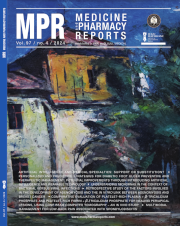Clonal distribution and molecular characterization of Staphylococcus aureus isolated strains in Chania and Heraklion, Crete
DOI:
https://doi.org/10.15386/mpr-2783Keywords:
Staphylococcus aureus (S. aureus), Plv (Panton-Valentine leucocidin), MRSA (Methicillin-resistant S. aureus), Hospital-Associated MRSA (HA-MRSA), Community-Associated MRSA (CA-MRSA), MSSA (Methicillin-sensitive S. aureus), PCR (Polymerase Chain Reaction)Abstract
Aim. This study investigates the demographic distribution, antibiotic resistance profiles, and molecular characteristics of Staphylococcus aureus infections.
Methods. The study was carried out in 141 patients, 60.4% male, in patients from Chania and Heraklion, Crete.
Results. The highest infection prevalence observed in the older adults (≥65 years) age group. The predominant infection types were skin lesions (39.72) and respiratory tract infection (22.7%). Antibiotic resistance testing revealed that 57.44% of strains were MRSA, with high resistance to Tetracycline, Ciprofloxacin, Kanamycine Erythromycin and Clindamycin. Molecular analysis showed 19.14% of strains were Pvl-positive, highlighting the presence of both MRSA and MSSA strains with Pvl genes.
Conclusions. The study underscores the need for continuous surveillance and targeted infection control strategies to manage the spread of MRSA, particularly in vulnerable populations.
Downloads
Published
How to Cite
Issue
Section
License
The authors are required to transfer the copyright of the published paper to the journal. This is done by agreeing to sign the Copyright Assignment Form. Whenever the case, authors are also required to send permissions to reproduce material (such as illustrations) from the copyright holder.

The papers published in the journal are licensed under a Creative Commons Attribution-NonCommercial-NoDerivatives 4.0 International License.

